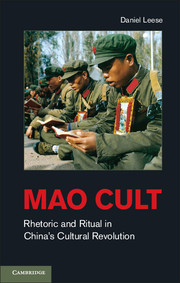Book contents
- Frontmatter
- Contents
- Illustrations, Figures, Maps, and Table
- Preface
- Chronology of Major Events
- Abbreviations
- Map Administrative divisions of China
- Introduction
- Part One Coming to Terms with the “Cult of the Individual”
- Part Two Charismatic Mobilization
- Part Three Cult and Compliance
- Conclusion
- Bibliography
- Glossary
- Index
Part Two - Charismatic Mobilization
Published online by Cambridge University Press: 07 October 2011
- Frontmatter
- Contents
- Illustrations, Figures, Maps, and Table
- Preface
- Chronology of Major Events
- Abbreviations
- Map Administrative divisions of China
- Introduction
- Part One Coming to Terms with the “Cult of the Individual”
- Part Two Charismatic Mobilization
- Part Three Cult and Compliance
- Conclusion
- Bibliography
- Glossary
- Index
Summary
The personality cult fostered around Mao Zedong had started prior to the founding of the People’s Republic and had developed in close rivalry with the projected image of Chiang Kai-shek as sole legitimate national Chinese leader. However, only after Stalin’s death and Khrushchev’s secret speech had the cult been turned from an unquestioned employed device of rule into a theoretical concept in need of explanation. Although the roots of the first Mao cult traced back to Yan’an, the Cultural Revolutionary leader cult was clearly shaped by the forms of worship developed in the PLA under the auspices of Lin Biao after 1959. The ritualization of behavior and speech by way of framing conduct according to short quotations from Chairman Mao had a huge impact on the further development of the cult. Mao consciously employed the cult in the mid-1960s to mobilize the masses against the party bureaucracy. With the destruction of the Leninist party system and clear hierarchies, however, the aims and strategies of employing the cult and its symbols came to vary increasingly. The ensuing cult anarchy revealed the variety in which out-of-context citations could be invoked and the futility of steering a political campaign through the manipulation of symbols alone.
- Type
- Chapter
- Information
- Mao CultRhetoric and Ritual in China's Cultural Revolution, pp. 87 - 88Publisher: Cambridge University PressPrint publication year: 2011



